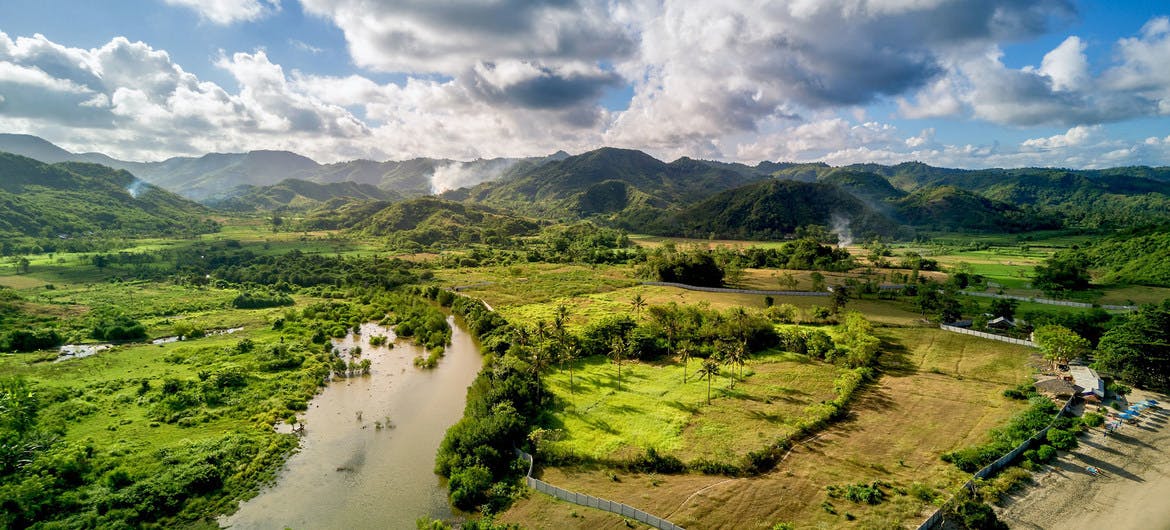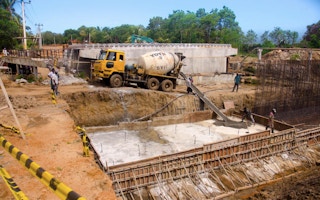The pressure is mounting on the world’s multilateral development banks to give greater clarity on green lending. Days before policymakers meet in Glasgow for the global COP26 climate talks, the Beijing-based Asian Infrastructure Investment Bank (AIIB) has put a precise figure on how much it will commit to climate finance approvals for infrastructure building in the region: US$50 billion by 2030.
To continue reading, subscribe to Eco‑Business.
There's something for everyone. We offer a range of subscription plans.
- Access our stories and receive our Insights Weekly newsletter with the free EB Member plan.
- Unlock unlimited access to our content and archive with EB Circle.
- Publish your content with EB Premium.
At a press conference held at the sidelines of the bank’s annual board of governors’ meeting in the United Arab Emirates on Tuesday, AIIB president Jin Liqun unveiled a three-point approach that the bank will take in financing infrastructure solutions to help Asia build greater resilience against climate change.
Its top priority is to ramp up efforts to close the current climate financing gap and align public-to-private financial flows more closely with the goals of the Paris Agreement by 1 July 2023, said Jin.
The AIIB also announced that it will implement initiatives to “drive investments and mobilise private capital to accelerate inclusive low-carbon growth” and proactively integrate climate mitigation and adaptation measures into its infrastructure investments.
“Climate change is a real and present danger. Asia will be exposed to catastrophic risks and … the environmental costs for not committing to a clear target for infrastructure green lending are too high to ignore,” said Jin.
Earlier this year, the AIIB announced that it is aiming for at least 50 per cent of overall approved financing by 2025 to be directed towards climate financing. At the press conference, Jin reported that climate finance currently accounts for 41 per cent of the bank’s infrastructure portfolio. He called for more private sector support in helping the bank meet its “ambitious target”.
“It will be the crux of our strategy to crowd more private-sector capital into projects and help enhance investments in adaptation and resilience for our low-income members,” he said.
The AIIB’s commitment to align to Paris Agreement goals will apply to sovereign and non-sovereign projects, including investments made via financial intermediaries.
Since its launch in 2016, the AIIB has approved 144 projects worth $28.5 billion in 31 countries. It started with 57 founding members and now has 103. Finance is critical to low-income and climate-vulnerable countries when it comes to meeting their domestic emissions reduction targets.
Loopholes found in AIIB’s environmental safeguards
The bank is, however, facing intense scrutiny for how it green-lights infrastructure projects in the region. In multiple reports published this month, ahead of the COP26 summit, AIIB’s newly-revised Environmental and Social Framework (ESF), a mechanism that guides the bank and its clients in the management of environmental documentation and disclosure in projects, has been called out for its lack of transparency and accountability.
A joint study by the Heinrich Böll Foundation, a non-profit foundation affiliated to a political party in Germany, and Just Finance International, found weak implementation of the bank’s amended framework.

The AIIB has been criticised for a lack of due diligence to mitigate how a $3 billion tourism project on Lombok Island will impact on the local community. Source: Unsplash
For example, for the Mandalika Urban Development and Tourism project in Lombok Island, the AIIB’s first standalone infrastructure project in Indonesia, the ESF assessment failed to disclose “critical aspects relating to resettlement, land acquisition and livelihood restoration that matters to protecting the rights of the indigeneous people impacted by the project”, said the study.
Both the AIIB and its client, the Indonesian Tourism Development Corporation, claimed that 92.7 per cent of the land to be acquired for the project would be free of land disputes. However, the study found that land grabbing and involuntary displacement occurred in the Mandalika region for many years leading up to the approval of the mammoth project.
Investigations by non-governmental organisations revealed that whole communities on the island were removed from their dwelling places without consent.
Climate finance key to low-carbon transition
The AIIB also remains a generous investor in fossil fuels. According to statistics from Recourse, an organisation that looks at the flows of development finance, 20 per cent ($3.8 billion) of the bank’s investments were in the energy sector, as of July 2020, with 54 per cent of those being in fossil fuels.
In a recent report, Recourse said that 2022 will be a crucial year to get the AIIB on a “green pathway”.
“The bank’s current strategy is far from green and it allows it to support all fossil fuels, thus undermining the very essence of the Paris Agreement,” the report said.
“
The environmental costs for not committing to a clear target for infrastructure green lending are too high to ignore.
Jin Liqun, president of the Asian Infrastructure Investment Bank
As COP26 draws near, multilateral development banks are scurrying to announce new pledges that will help them meet the demands of a world that seeks more aggressive green financing reform. This month, the Asian Development Bank (ADB), another multilateral institution, pledged to increase climate financing by US$20 billion to US$100 billion by 2030.
The trend for global financial institutions to divest from coal has been gathering pace too. In an announcement made last year, the AIIB has said that its new no-coal pledge will improve the reputation of China’s massive Belt and Road Initiative.
Last year, climate finance committed by major multilateral development banks rose to a total of $66 billion from $61.6 billion in 2019, according to the Joint Report on Multilateral Development Banks’ Climate Finance. Of this, 58 per cent—or $38 billion—was committed to low- and middle-income economies.










